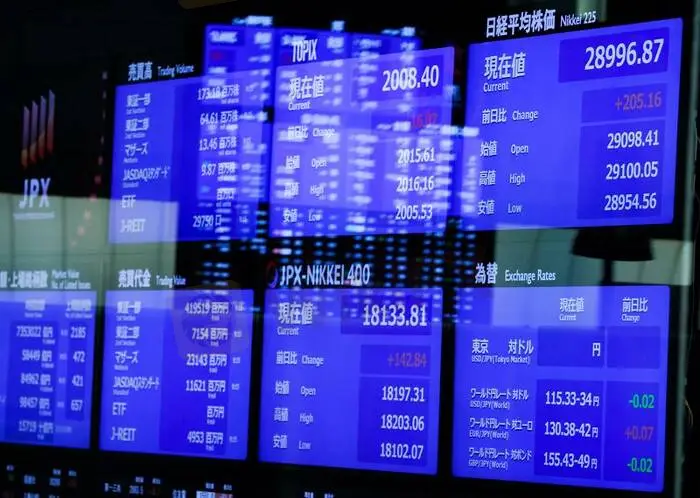简体中文
繁體中文
English
Pусский
日本語
ภาษาไทย
Tiếng Việt
Bahasa Indonesia
Español
हिन्दी
Filippiiniläinen
Français
Deutsch
Português
Türkçe
한국어
العربية
Gold, oil rise on Ukraine crisis; U.S. stocks end flat
Abstract:Asian shares rallied on Wednesday as fears of a Russian invasion of the Ukraine this week dissipated after Moscow indicated it was returning some troops to base from exercises, delivering investors a measure of relief.
Oil and gold rose on Wednesday after NATO and the United States said Russia was increasing its troop build-up near Ukraine, while a dovish reading of minutes from the last Federal Reserve meeting helped stocks close mostly flat on Wall Street.
Stronger-than-expected U.S. retail sales data and higher inflation readings from Canada and Britain added to the outlook for tighter monetary policy worldwide, but geopolitical tensions kept markets for the most part focused on the Ukraine standoff.
Fed policymakers agreed it was time to raise interest rates but that any decision would depend on an analysis of inflation and other data each time they met, minutes from their two-day meeting in late January showed.
“The reading of the Fed minutes is less hawkish, less aggressive rate hikes, at least initially,” said Tim Ghriskey, senior portfolio strategist at Ingalls & Snyder.
“The minutes are little bit more dovish than we heard (Fed Chair Jerome) Powell talk in the post Fed meeting press conference in January,” Ghriskey added.
On Wall Street, the Dow Jones Industrial Average fell 0.16%, the S&P 500 gained 0.09% and the Nasdaq Composite dropped 0.11%. All 11 sectors of the S&P early in the session were higher, with the exception of the energy index, but stocks pared losses after the Fed minutes came out.
MSCIs gauge of stocks across the globe reversed course to post a 0.32% gain, while its emerging markets index rose 1.23%.
Sharp gains earlier in Asian equity markets on Tuesdays news that Russia was withdrawing some troops faded in the European session, with the STOXX 600 pan-European index ceding some early gains to close barely up 0.04%.
NATO questioned Moscows stated willingness to negotiate a solution to the crisis, one of the deepest in East-West relations in decades, and accused Russia of increasing its massive military build-up surrounding Ukraine.
U.S. Secretary of State Antony Blinken backed the assessment, an outlook that lifted the price of safe-haven gold and boosted crude oil along with related assets as supply would be further constrained by an invasion.
“There are not really any signs of de-escalation. Thats going to put commodities likely on firmer footing given that extent supply and inventories are really low,” said Bipan Rai, North America head of FX strategy at CIBC Capital Markets.
U.S. crude futures rose $1.59 to settle at $93.66 a barrel, while Brent settled up $1.53 at $94.81.
The Russian ruble gained 0.64% to 75.12 per dollar as fears of immediate military action waned, for the moment.
Earlier, U.S. retail sales rebounded sharply in January amid a surge in purchases of motor vehicles and other goods, but higher prices could blunt the impact on economic growth this quarter. [L1N2UR17V]
Data showed retail sales rose 3.8% last month, almost double the consensus forecast by economists of a 2.0% gain.
Spot gold, which on Tuesday hit the highest level since June 2021 at around $1,879 per ounce, added 0.8% to $1,867.51.
U.S. gold futures settled down 0.8% at $1,871.50.
Inflation was still a market concern as data in Britain showed consumer prices increased at the fastest annual pace in nearly 30 years, reinforcing chances that the Bank of England will raise rates for a third meeting in a row.
Canadas annual inflation rate accelerated again in January to hit a fresh 30-year high of 5.1%, bolstering the case for a steady series of interest rate hikes.
U.S. Treasury and euro zone government bond yields extended their decline. The yield on 10-year Treasury notes was down 0.5 basis points to 2.040%.
The two-year U.S. Treasury yield, which typically moves in step with interest rate expectations, fell 3.4 basis points to 1.535%. Earlier it touched a low of 1.496%.
The dollar index fell 0.215%, with the euro up 0.18% to $1.1376.
GRAPHIC: Treasury yield curve – https://fingfx.thomsonreuters.com/gfx/mkt/dwpkrjbeyvm/3M10Y%20Curve.JPG
(Reporting by Sujata Rao in London and Daniel Leussink in Tokyo; Editing by Michael Urquhart, Will Dunham, Mark Potter, Kirsten Donovan)

Disclaimer:
The views in this article only represent the author's personal views, and do not constitute investment advice on this platform. This platform does not guarantee the accuracy, completeness and timeliness of the information in the article, and will not be liable for any loss caused by the use of or reliance on the information in the article.
WikiFX Broker
Latest News
Exposing the Top 5 Scam Brokers of March 2025: A Closer Look by WikiFX
Gold Prices Climb Again – Have Investors Seized the Opportunity?
Webull Launches SMSF Investment Platform with Zero Fees
Australian Regulator Warns of Money Laundering and Fraud Risks in Crypto ATMs
FCA Warns Against 10 Unlicensed or Clone Firms
CySEC Warns Against 14 Unlicensed Investment Websites
Top Currency Pairs to Watch for Profit This Week - March 31, 2025
Will natural disasters have an impact on the forex market?
Philippines Deports 29 Indonesians Linked to Online Scam Syndicate in Manila
AI-Powered Strategies to Improve Profits in Forex Trading
Currency Calculator







